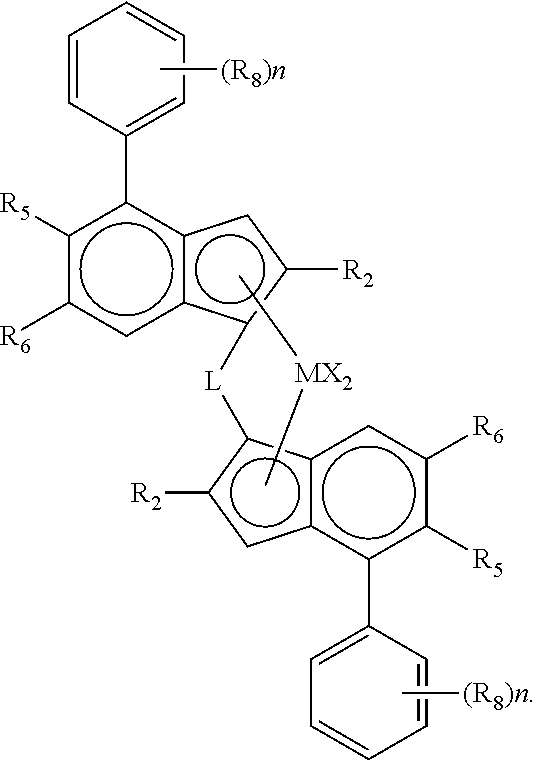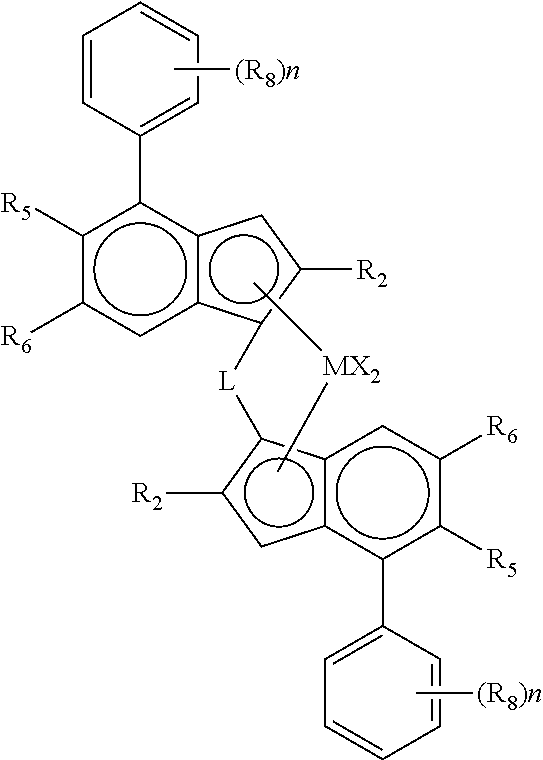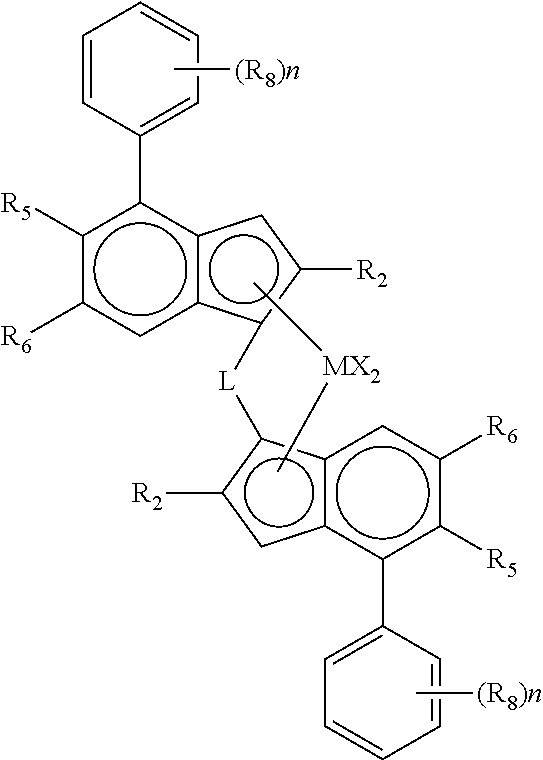catalyst
a technology of bisindenyl and catalyst, which is applied in the field of new bisindenyl catalysts, can solve the problems of molecular weight polypropylene and polypropylene manufacturing
- Summary
- Abstract
- Description
- Claims
- Application Information
AI Technical Summary
Benefits of technology
Problems solved by technology
Method used
Image
Examples
examples
Chemicals
[0201]All the chemicals and chemical reactions were handled under an inert gas atmosphere using Schlenk and glovebox techniques, with oven-dried glassware, syringes, needles or cannulas.
[0202]MAO was purchased from Albermarle and used as a 30 wt-% solution in toluene.
[0203]The mixture of perfluoroalkylethyl acrylate esters (CAS 65605-70-1) used as the surfactant was purchased from the Cytonix corporation, dried over activated molecular sieves (2 times) and degassed by argon bubbling prior to use.
[0204]Perfluoro-1,3-dimethylcyclohexane (PFC, CAS 335-27-3) was dried over activated molecular sieves (2 times) and degassed by argon bubbling prior to use.
[0205]Triethylaluminum was purchased from Crompton and used in pure form. Hydrogen is provided by AGA and purified before use.
[0206]Propylene is provided by Borealis and adequately purified before use. 2 M HCl, 12 M HCl (Reachim, Russia), silica gel 60 (40-63 um, Merck), K2CO3 (Merck), ZrCl4(THF)2 magnesium turnings (Acros), TsOH...
example e1
Catalyst Example E1
rac-Me2Si[2-Me-4-(3,5-tBu2Ph)Ind]2ZrCl2 (MC1)
[0224]Inside the glovebox, 80 μL, of dry and degassed surfactant solution were mixed with 2 mL of MAO in a septum bottle and left to react overnight. The following day, 64.9 mg of the metallocene rac-Me2Si[2-Me-4-(3,5-tBu2Ph)Ind]2ZrCl2 / MAO (0.076 mmol, 1 equivalent) were dissolved with 4 mL of the MAO solution in another septum bottle and left to stir inside the glovebox.
[0225]After 60 minutes, 1 mL of the surfactant solution and the 4 mL of the MAO-metallocene solution were successively added into a 50 mL emulsification glass reactor containing 40 mL of PFC at −10° C. and equipped with an overhead stirrer (stirring speed=600 rpm). Total amount of MAO is 5 mL (300 equivalents). A red-orange emulsion formed immediately (measured emulsion stability=17 seconds) and stirred during 15 minutes at 0° C. / 600 rpm. Then the emulsion was transferred via a 2 / 4 teflon tube to 100 mL of hot PFC at 90° C., and stirred at 600 rpm until...
PUM
| Property | Measurement | Unit |
|---|---|---|
| Tm | aaaaa | aaaaa |
| melting point | aaaaa | aaaaa |
| melting point | aaaaa | aaaaa |
Abstract
Description
Claims
Application Information
 Login to View More
Login to View More - R&D
- Intellectual Property
- Life Sciences
- Materials
- Tech Scout
- Unparalleled Data Quality
- Higher Quality Content
- 60% Fewer Hallucinations
Browse by: Latest US Patents, China's latest patents, Technical Efficacy Thesaurus, Application Domain, Technology Topic, Popular Technical Reports.
© 2025 PatSnap. All rights reserved.Legal|Privacy policy|Modern Slavery Act Transparency Statement|Sitemap|About US| Contact US: help@patsnap.com



